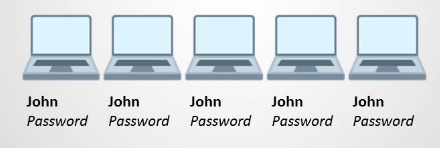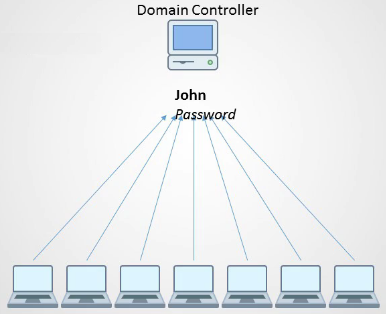< Main Menu | 4 Intro to Group Policy Management >
11: What is Active Directory Users & Computers
https://www.udemy.com/active-directory-group-policy-2012/learn/v4/t/lecture/8276670?start=0
Active Directory
Active Directory (AD) is a database (or Directory [think Phone directory]) for the following and their respective permissions:
- User Accounts & Passwords
- Computers
- Printers
- File Shares
- Security Groups
Security Groups
Use AD and Group Policies together to define specific permissions to objects within AD
- User Accounts
- Computers
- Printers
- File Shares
- Other Groups…
The Purpose for Active Directory
- is to handle security authentication across a domain
- Only allows authorized users to logon to network computers
- Centralized security management of network resources.
- Stores things like user names and passwords in 1 location instead of each individual computer.
Most common Task with AD
- Reset Passwords
- Create/Delete user accounts
- Every time a new employee is hired, they will need log in credentials
Life without AD
- User “John” requires access to several computers in the office.
- You would need to create his login on each one.
- If John lost his password, you would also need to reset it on each one.
With AD
- Setup once
- Reset in one location
Active Directory is a Multi-Master Database
- Several computers can make changes to the database
Getting Started
- Server Manager > Tools > Active Directory Users and Computers
- Nav Pane > RtClck Domain > New to add users and computers
The rest is a walk through of all options in the Users and Computers admin window.
12: Understanding Organizational Units and Containers
https://www.udemy.com/active-directory-group-policy-2012/learn/v4/t/lecture/8276672?start=0
Active Directory Users and Computers > domain.tld
What are Containers?
- Are structural objects that are included by default within Active Directory.
- You cannot apply Group Policy Objects (aka GPOs) to Containers *IMPORTANT
- You cannot create a Container with AD
- (but you can use adsiedit but likely never required)
Think of Containers as Organizers
Computers Container
- Serves as a default location for new computers that join your domain.
- When joined, a new AD Computer Account Object will be created inside this container.
- To apply GPOs to a computer, you’ll need to move that computer out of the container and into an Organizational Unit (then you can apply security policies such as custom wallpapers, etc.)
- You can leave them in the Computers container, but generally not best practice.
ForeignSecurityPrincipals Container
- Contains Proxy Objects for Security Principals for other trusted domains.
- Could be a user account or security group that resides inside of another domain.
- If you do not establish a trust between this domain and another, you will not be using this container at all.
Managed Service Accounts (MSAs) Container
- Holds the user accounts that are used to operate the applications or services that run on your servers or workstations.
- apache2, www-data
- These accounts do not use passwords – these are handled automatically.
- To create an MSA, you need to use the PowerShell command line. There is no Gui.
Users Container
- Do not delete any of the default users and security groups!
builtinDomain
- Contains a number of Security Groups required for the domain to operate
- Unlike Users, these cannot be deleted
Organizational Units (OUs)
- Used to organize and separate objects within AD.
- Objects can be anything that AD can store
- User Accounts
- Computers, Printers, blah blah
- If you have a Marketing Team, you can create an OU called Marketing and store all those users there.
- You can assign specific permissions to OUs, that then automatically apply to all objects within that OU.
Domain Controllers OU
- Only OU that comes by default. This cannot be deleted.
- Domain Controllers need to be placed inside this OU because there are specific policies that need to be applied to Domain Controllers for them to operate.
Creating a new OU
- domain.tld [RtClk] > New > Organizational Unit
- Name: Test OU > [ Save ]
- Test OU [RtClk]
- Delegate Control…
- Give control of this OU to another person
- Delegate Control…
Exporting a List
- Right click on an OU to export a list of it’s sub contents.
- These lists are not recursive, so the list will only be 1 level deep if you have nested OUs.
Deleting an OU
- If you cannot delete an OU, it may be protected. To disable accidental deletion:
- View > Advanced Features
- Target OU [RtClk] > Properties
- Click the Object tab, then deselect “Protect against accidental deletion”
Additional Notes here: https://wiki.thomasandsofia.com/active-directory-users-and-computers/
13: Creating User Accounts with AD
https://www.udemy.com/course/active-directory-group-policy-2012/learn/lecture/8287548#content
Create the OUs for your users and computers
- [RtClk] AD Domain name (domain.tld) > New > Organizational Unit
- Name: domain
.tld- Standard procedure is this should be the same to prevent misinterpretation.
- Did not use the existing ‘Users’ container because you CANNOT apply group policies to containers!
- Within this OU, create 2 sub OUs
- ‘Domain Users’
- ‘Domain Computers’
Create a user
- [RtClk] Domain Users > New > User
- Enter
- First/Last names
- Login name: first.last or however you wish
- Select domain from drop down (should only have one now)
- due to character limits in pre-2000, you can use an alt. login name
- Next >
- Create / Confirm password
- Select password options
- In ‘Production’ would probably leave the ‘User must change at next logon’ enabled.
- This is also where you disable an active directory user account.
- Next > Finish
- Attempt to sign in with your user.
14: Searching for Objects in AD
https://www.udemy.com/course/active-directory-group-policy-2012/learn/lecture/8300688#content
Purpose:
- If you have 1000’s of users or computers
How to find objects and users
- Use the ‘Find’ icon
- [RtClk] the domain > Find
- Select the type of object you are looking for
- Users, Contacts, and Groups
- Computers
- Printers
- Shared Folders
- Organizational Units
- Customer Search
- Common Queries
- Select the Domain to search
- You can use ‘Entire Directory’ but if you have trusted domains, this search could take a very long time to complete.
- Click [ Find Now ]
- When the object has been located, [RtClk] to perform common tasks
- Rename
- delete
- add to group
- Reset Password
- Disable account
- Nothing in this view will show you “Where” the located object is.
To find where an Object is:
- View > Advanced Features > Enable
- Repeat ‘Find’ steps above > Properties
- Click the ‘Object’ tab
- Canonical name of object “tas.local/tas/Domain Users/Thomas Roberts
- domain/domainOU/userOU/user
Advanced Search
- Accepts RegEx
15: Resetting User Passwords in AD Users and Computers
https://www.udemy.com/course/active-directory-group-policy-2012/learn/lecture/8300702#content
How to reset a user’s password
- Find using users First and Last name
- Double click > Account tab or [RtClk] > Properties > Account tab
- Make sure you ask for their Login Name
- This helps prevent accidentally resetting the WRONG user
- [RtClk] User > Reset Password …
Unlocking an account
- On the account tab.
- Can do from the Password reset screen, but will require a password change.
16: Understanding Groups and Memberships
https://www.udemy.com/course/active-directory-group-policy-2012/learn/lecture/8351366#content
IMPORTANT to know how groups work!
Create a Group
- Domain (tas.local)> Domain OU (tas)> Users OU (Domain Users)> [RtClk] New > Group
- Group: Sales
- Select Scope (Least to most accessible)
- Domain Local: ONLY to the local domain (tas.local)
- Global: Includes trusted domains
- Universal: Can be accessed from other forests that trust your domain
- Group Types
- Security: Used to specify permissions
- printers
- file shares
- Distribution Group
- Only used as an Email distribution list.
- Security: Used to specify permissions
Example Group: Sales
- Create the group
- Name: Sales
- Scope: Global
- Type: Security
- [ OK ]
- [RtClk] Sales > Properties
- Members Tab: Add users to the group
- [Add]
- Find User
- Start typing > Check Names
- [ OK ]
- Member Of: Add the group to another OU
- Example: Can add Sales to the Administrators group
- Members Tab: Add users to the group
17: Disabling and Deleting User Accounts with AD
https://www.udemy.com/course/active-directory-group-policy-2012/learn/lecture/8351662#content
Disabling a user account
Often a user should not be deleted until a certain amount of time has expired.
- Create an OU called ‘Disabled Users’
- Domain (tas.local)> Domain OU (tas)> [RtClk] New > Organizational Unit > Disabled Users
- Disable the account:
- Select the account, [RtClk] > Disable User
- Move account to ‘Disabled Users” OU
- Select account, [RtClk] > Move
- Select OU to move to
- * I tried dragging and dropping the user, but it barked at me…
Deleting a user account
- Select the account, [RtClk] > Disable User
Quiz 1: AD Quiz
https://www.udemy.com/course/active-directory-group-policy-2012/learn/quiz/425420#content
4/27/2020


